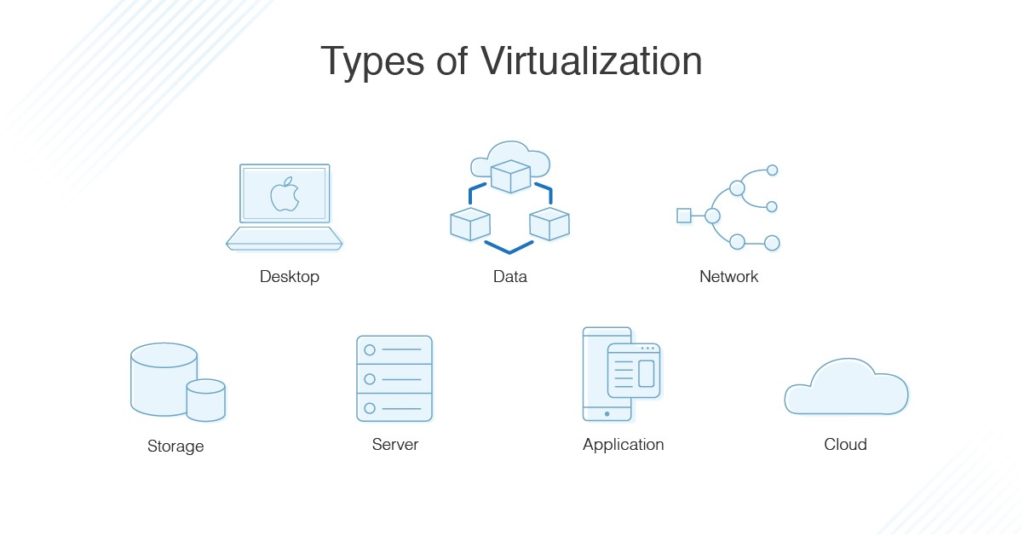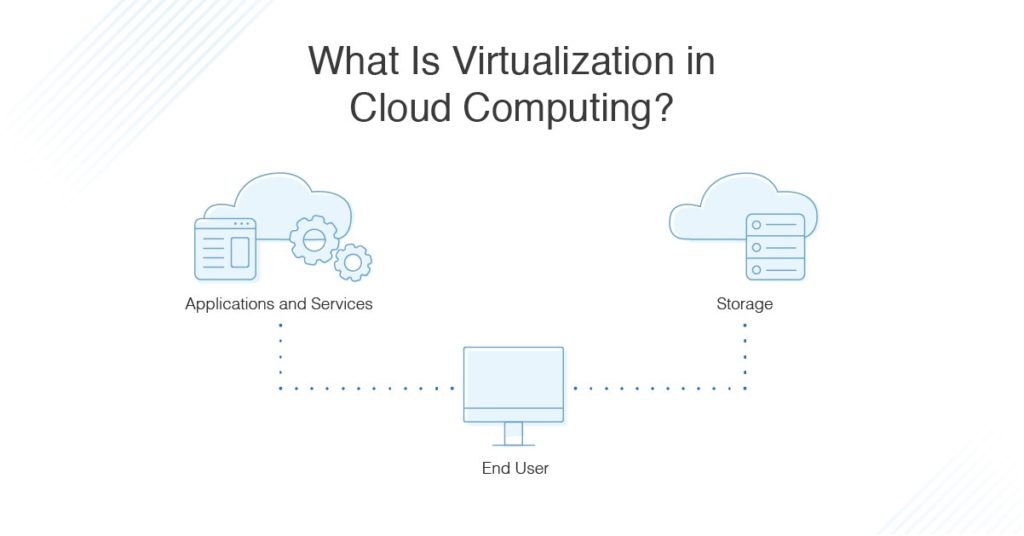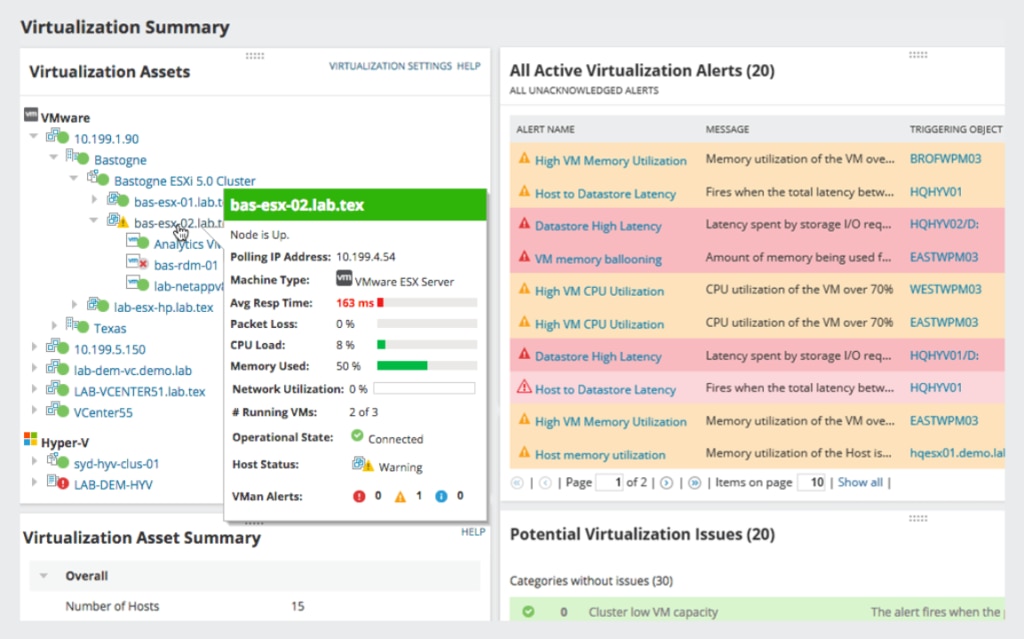The advent of virtualization technology revolutionized the way hardware could be used in many different businesses. Virtualization of applications and desktops has allowed easier access to users and employees, making remote work increasingly possible, and the virtualization of networks, storage, and servers improved efficiency and performance metrics for organizations in need of powerful and reliable infrastructure.
Cloud computing and the various cloud services provided these days rely on cloud virtualization, which is one type of virtualization technology. When cloud storage is provided to users, applications and data can be stored on the cloud and accessed from any location. Below, I’ll explain how virtualization works, the different types of virtualization, and what cloud virtualization means. I’ll also briefly touch on the importance of managing your virtual systems with the right software tools, and review why I enjoy using my my top recommendation for virtual machine monitoring, SolarWinds® Virtualization Manager.
How Virtualization Works
Types of Virtualization
What Is Virtualization in Cloud Computing?
Why Use Virtualization?
Best Virtualization Monitoring Tools
What to Know About Managing Virtual Systems
How Virtualization Works
Virtualization is the process of creating a virtual instance of a device, such as a virtual server or virtual operating system. There are several different types of virtualization, which I’ll discuss shortly in more detail.
Most virtualization is performed through virtualization software. These programs have the capability to extend the hardware of the physical machine, network, or storage system, and create virtual versions of these systems.
One example of a virtualization program is called a hypervisor, which can virtualize desktops, applications, network components, and storage. Hypervisors can either be installed directly on the hardware, or work as a layer installed on the operating system between the hardware and the virtual machine.
Types of Virtualization

There are numerous different types of virtualization, and it’s important to understand cloud virtualization is simply one type of virtualization technology. Cloud computing isn’t different from virtualization, but it uses virtualization to function. Before we get to cloud virtualization, the other kinds of virtualization are:
- Desktop Virtualization: Desktop virtualization is commonly performed using hypervisors, particularly when the operating system installed on the user’s device is different than the one they want to use. For example, a user using a computer with Windows installed may then use a hypervisor to virtualize a Linux desktop, so they can test programs in development in a Linux environment.
- Data Virtualization: Data virtualization is when data is managed to allow the user to user change or access data without needing to know exactly where it’s stored or what format it’s in. Data is aggregated without moving or changing the original data, so it can be quickly accessed from any device.
- Network Virtualization: Network virtualization is when physical networks are combined into a virtual network based on software instead of hardware. All the physical parts of the network, such as switches and routers, are pooled, and their resources can be allocated as needed to any user or device on the network. This is done through a central virtual network management system. A common type of virtual network is a virtual local area network, or VLAN. A VLAN combines several network devices into one group, as if they were a LAN, even if they’re not in local proximity to each other.
- Storage Virtualization: Storage virtualization is the process of combining a group of physical storage devices into one group as if they were one device. A commonly known type of virtual storage is called a Storage Area Network, or SAN. Storage virtualization allows applications and servers to access information from storage systems without needing to know which physical or virtual device the data is stored on. Virtualizing storage allows data to be easily backed up and transported between locations, and data can be more easily accessed.
- Server Virtualization: This is when more than one virtual server can be stored on one physical server. Instead of purchasing more and more physical servers, you can save on floor or room space, and instead virtualize multiple servers and store them on one single machine instead. It also means you can easily allocate physical resources between different servers and change it as necessary. You can easily move the virtual servers from one host server to another. (For more information about server virtualization, read my in-depth guide on what is virtualization.)
- Application Virtualization: This is when an application is stored virtually on a server and then accessed by the user’s device through the server, instead of being installed directly on the device. This means users don’t need to log on to a computer to access an application, and instead they can access it through any device with access to the server (such as through the internet). This also means you don’t need to have enough storage space on your device to be able to install and use an application, as the application is stored on the server elsewhere.
What Is Virtualization in Cloud Computing?

Virtualization in cloud computing isn’t easily contrasted with virtualization technology—it uses virtualization technology. Cloud computing is a type of service uses virtualization technology, like the other types we discussed above.
With cloud virtualization, customers can use only the parts of the service or resources they need, without needing the accompanying physical infrastructure themselves. For example, cloud virtualization technology for storage infrastructure allows users to access huge amounts of storage as they need it, and scale this need up and down as necessary, without needing any of their own storage.
Virtualization in cloud computing allows a provider to virtualize servers, storage, or other physical hardware or data center resources, which can then, in turn, allow them to provide numerous services such as infrastructure, software, and platforms.
Infrastructure as a service (IaaS) allows users to access cloud-based servers, storage, and network resources: an entire infrastructure accessible through cloud virtualization technology. It means users don’t need to create or purchase this infrastructure themselves, but they can use the virtualized version. Most people are also familiar with Software as a Service (SaaS), which is software abstracted from hardware and accessed over the cloud.
Why Use Virtualization?
There are several reasons virtualization of one of the above types is increasingly used, as there are numerous benefits. For example, in the case of server, storage, desktop, and application virtualization, having physical devices or copies of these things can be difficult to move or copy when you need to move something. A virtual server or desktop can be easily moved and accessed from a different location.
In addition, physical devices are limited by the specific set of hardware they’re installed on, while virtual devices can easily be allocated resources as necessary. Physical hardware can be consolidated, and a virtual machine could access resources from multiple pieces of hardware.
Furthermore, the level of isolation of virtual devices provides two main benefits: security and resistance to change. When a virtual machine is created, it’s completely isolated from other virtual machines and from the host system. If one virtual machine or one physical device is infected with malware, it won’t necessarily be able to easily spread through other virtual machines or other parts of the network. This level of security is useful for protecting your network when virtual machines access the internet and for testing applications or new developments. For example, if an application crashes on a virtual machine, it won’t cause any problems for the host machine beneath it.
Best Virtualization Monitoring Tools
With all these different types of virtualization, it’s also important to have software or a program capable of managing systems and monitoring your virtual machines. I suggest a tool like SolarWinds Virtualization Manager, which can integrate with your hypervisors and virtual machines for improved visibility across your entire virtual domain.

For example, if you use virtual SANs (virtual storage), you need a tool to keep track of VM performance, capacity, and other potential issues. Ensuring you have good performance metrics at all times allows you to look at historic data to see where issues arose, be alerted to problems when they occur, and engage in VM capacity planning, so you can provision new virtual machines or rearrange networks as necessary. Virtualization Manager from SolarWinds is designed to provide all these features and more.
What to Know About Managing Virtual Systems
Virtualization technology is becoming increasingly widespread, and understanding how and why virtualization works is critical for information technology, network management, and network administration in large organizations. People are becoming more familiar with cloud virtualization, and many home and small-business users are using cloud systems without even knowing it. Cloud virtualization, in the form of IaaS, SaaS, and PaaS (Platform as a Service), is also becoming a large part of many organizations.
It’s highly likely you’ll deal with virtual machines or cloud virtualization at some point soon if you aren’t already. The key next step is to gain a deeper understanding of what virtualization technology is and how it functions, as well as looking into how to monitor and manage any virtual systems you already oversee with a tool like SolarWinds Virtualization Manager.


